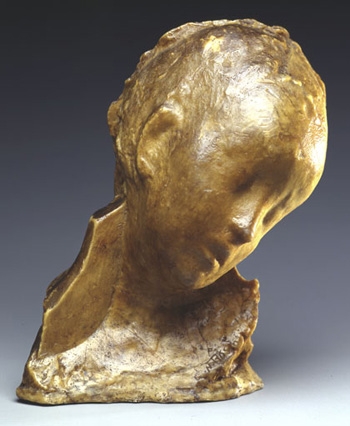
Unfortunately, Bimbo Malato (Sick Boy) is not currently on display in the Museum. Thank you for your understanding. Audio guide length: 2 minutes, 24 seconds.
Link to next piece in highlights tour: Camel and Rider
Transcript
This sculpture is called Bimbo Malato, Italian for Sick Boy. It portrays the drooping head and neck of a sick child. The sculpture is made of wax filled with plaster and was created in 1893 by the artist Medardo Rosso. It is slightly smaller than life sized, about 10 and ½ inches tall, 9 and ½ inches wide, and 7 inches deep.
At first glance, this piece looks similar to marble portraits of Ancient Roman leaders. A closer look, however, tells a much different story. Instead of marble, the piece is made from a slippery, yellowing wax, creating a feeling of disease. Rather than a strong pose gazing ahead, the young boy is slumped over, too weak and sickly to hold up his head. The child’s head is bent to his left—the viewer’s right. He has little to no hair, his eyes are closed, and his mouth is slightly parted. The piece’s waxy material combined with the child’s wilted pose creates the feeling that he is melting.
[If you would like further description and analysis of this sculpture, please continue listening or reading.]
The back of the sick boy’s head and his collarbone descend into rough, brown bumps. A jagged background juts out from his neck on the viewer’s left side, creating the sense that the image was chipped away like a half-finished stone sculpture.
Historically, sculptures have been made to remember important people and events. These images were often preserved in long-lasting material like bronze and marble. Medardo Rosso, the artist of Sick Boy, did the opposite. He often made artwork of people who were not typically associated with power, such as elderly people, children, and the poor. The sick child in this piece is probably based on a real person Rosso met in a Paris hospital. Rosso’s use of fragile material and vulnerable subjects to convey fleeting moments made him an important rule-breaker in the history of sculpture.